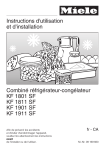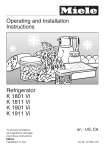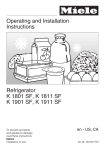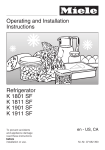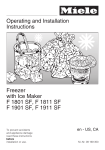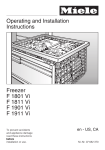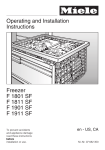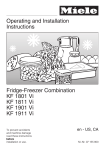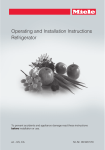Download Miele F 1801 SF Installation manual
Transcript
Operating and Installation Instructions Fridge-Freezer Combination KF 1801 SF KF 1811 SF KF 1901 SF KF 1911 SF To prevent accidents and appliance damage read these instructions before installation or use. en - US, CA M.-Nr. 09 169 650 Installation instructions Information is subject to change. Please refer to our website to obtain the most current product specification, technical & warranty information. To prevent accidents and machine damage read these instructions before installation or use. 49 Caring for the environment Disposal of packing materials Disposal of an old appliance The cardboard box and packing materials are biodegradable and recyclable. Please recycle. Old appliances contain materials that can be recycled. Please contact your local recycling center about the possibility of recycling these materials. Ensure that any plastic wrappings, bags, etc., are disposed of safely and kept out of the reach of babies and young children. Danger of suffocation! 50 Before discarding an old appliance, disconnect it from the electrical supply and cut off the power cord to prevent it from becoming a hazard. Installation Installation site Have the appliance installed by a qualified technician, according to the enclosed installation instructions. ,WARNING This appliance is top-heavy and must be secured to prevent it from tipping forward. Keep the doors closed until the appliance is completely installed and secured as per the installation instructions. Empty weight of your machine: KF 18X1 SF . . . . . . . . 511 lbs (232 kg) KF 19X1 SF . . . . . . . . 562 lbs (255 kg) The appliance should be installed in a dry, well-ventilated room. Do not install the appliance: - outdoors - in an environment with dripping water - in rooms that are at risk of frost. The installation location should not be exposed to direct sunlight, nor near a heat source, such as an oven, radiator, etc. The ambient temperature should not drop below 55°F (13°C) or rise above 110°F (43°C), otherwise malfunctions may occur. If installation next to a heat source is unavoidable observe the following minimum distances from the heat source: – 1 1/4" (3 cm) from an electric cooktop or electric oven. – 12" (30 cm) from a gas or oil cooktop, range or oven. 51 Installation Base Ventilation A fully loaded appliance is very heavy. The load-bearing capacity of your floor must meet the following requirements: The air intake and outlet must not be blocked or covered in any way. They also need to be dusted/cleaned on a regular basis. KF 18X1 SF . . . . . . . 1,007 lbs (457 kg) KF 19X1 SF . . . . . . . 1,250 lbs (567 kg) To ensure that the appliance is installed securely and functions properly, the base must be flat, level and made of a hard, rigid material. If in doubt, contact Miele. Furniture/fixtures The new appliance will be mounted securely to adjacent and overhead furniture/fixtures. For this reason, it is essential that all attachable furniture/fixtures be connected securely to the floor or wall by a suitable means. 52 Installation niche To ensure safe, trouble-free installation and the best possible cosmetic result, check to be sure that the installation space complies with the installation dimensions. See "Niche dimensions". The side walls of the installation cavity must be plumb. The minimum thickness of the side walls and the top wall must be 5/8" (16 mm). The minimum thickness of the toe-kick panel must be ½" (13 mm). A thickness of 3/4" (19 mm) is recommended. Installation Stainless steel panels Side-by-side Stainless steel door panels and toe-kick covers are available from Miele. This appliance can be installed "side-by-side" with another fridge/freezer using a "Merging Kit". Installation options The "Merging Kit" is available from Miele. There are many different installation options. You are limited only by the design of the kitchen. The door hinge cannot be exchanged. Single column The appliance can be installed at any preferred location in the kitchen. However, be sure the door will open and close properly in the chosen location. Contact Miele or your dealer for specific information about which combinations will work with your appliance. For instructions on how to attach the appliances and install the heating mat, please refer to the instructions included with the "Merging Kit", available from Miele. Appliances attached together using the "Merging Kit" If the appliances are installed directly next to each other (without a partition), they need to be attached together using the "Merging Kit". 53 Installation Installation with partition using the "Merging Kit" The minimum thickness of the partition is 5/8" (16 mm). Side panels If one side of the appliance is visible, a side panel must be used. The side panel must be firmly secured to the wall, the floor and the overhead furniture/fixtures before the appliance is placed in the cavity. The dimensions of the side panel are taken from the opposite wall of the installation space. During installation, ensure that the cavity is square and the measurements are correct. If there is a partition with a thickness from 5/8" (16 mm) to 6 5/16" (160 mm) between the adjacent appliances, then each appliance should be individually installed within its own niche using the mounting accessories included. The "Merging Kit" will also be needed. The "Merging Kit" is available from Miele. Installation with partition without using the "Merging Kit" If there is a partition with a thickness of more than 6 5/16" (160 mm) between the adjacent appliances, then each appliance should be individually installed within its own niche using the mounting accessories included (the "Merging Kit" is not necessary). 54 Installation Adjusting the door opening angle (optional accessory) Depending on the installation site, it may be necessary to adjust the door opening angle to 90°. ^ Open the door. ^ Insert the banking pin through the holes and drive in with a hammer. The door opening angle is now limited to 90°. 55 Dimensions Door dimensions (opening angle 90°) A KF 18X1 SF 32 5/8" (829 mm) KF 19X1 SF 38 11/16" (982 mm) Door dimensions (opening angle 115°) A KF 18X1 SF 32 5/8" (829 mm) B 14 5/16" (363 mm) KF 19X1 SF 38 11/16" (982 mm) 16 7/8" (428 mm) 56 Dimensions Niche dimensions A B KF 1801 SF, KF 1811 SF 30 ½" (774.6 mm) 30" (762 mm) KF 1901 SF, KF 1911 SF 36 ½" (927 mm) 36" (915 mm) 57 Dimensions Power supply and water connection 1. Power supply 2. Water connection A KF 18X1 SF 15" (381 mm) KF 19X1 SF 18" (458 mm) 58 Installing the appliance Before you begin Read these instructions completely and carefully. Have the appliance installed by a qualified technician, according to the enclosed installation instructions. To reduce the risk of injury or damage to the product, two people should be used for installation. These installation instructions are intended for use by qualified installers. In addition to these instructions, the appliance must be installed in accordance with all local codes. In the absence of a local code, the following should be used: – In the USA, the National Electric Code, ANSI/NFPA 70 - latest edition/State and Municipal codes and/or local codes. – In Canada, the Canadian Electric code C22.1 - latest edition/Provincial and Municipal codes and/or local codes. – Adhesive tape – Multi-grip pliers – Level – Tape measure – Square When fastening the cabinet to the wall behind it (see "Installing the appliance") use: – suitable plugs/screws depending on the type of wall. – several mounting brackets, if required. Other – Stepladder – Dolly, hand truck – Wooden beam (cross section min. 3" x 4" [75 mm x 100 mm] as an alternative tilt protection, length depends on the width of the installation cavity) – Wood screws in different sizes Optional accessories – "Merging Kit" for side-by-side installation Tools needed for installation – Cordless screwdriver – RemoteVision module for wireless monitoring – Torx screwdriver – Hammer drill – Wood drills in different sizes – Hammer – Rachet (5/16" / 8 mm) 59 Installing the appliance Aligning the housing unit Check the installation niche To ensure a safe, trouble-free installation and the best possible cosmetic result, check to be sure that the installation space complies with the installation requirements. ^ Check the base (see "Installation"). ^ Check the dimensions of the cavity. ^ Check that the cavity is square. ^ Check the location of the power outlet. ^ Check the location of the water connection (see "Plumbing"). The housing unit must be carefully aligned using a spirit level before installing the appliance. The unit corners must be at right angles, as otherwise the furniture door will not align correctly with the 4 corners of the appliance. – The side panels of the housing must be even. – The housing unit panels must be at least 16 mm thick. – The plinth facing must be at least 13 mm thick (or preferably 19 mm). ^ Check that all furniture parts in the vicinity of the appliance are securely connected to the wall. ^ Check that the adjacent furniture/fixtures do not collide with the open door. Before installation ,Caution - the appliance is very heavy. Use caution when unpacking and opening the door, danger of tipping. ^ To protect the base from damage during installation, attach a hard board, linoleum, etc., to the floor in front of the intended installation location. ^ Take the supplied accessories out of the protective packaging. 60 Installing the appliance There are transportation safety devices inside the appliance to protect the shelves and storage compartments until installation is complete. Do not remove them, or parts may be damaged. ^ Check the appliance for damage in transit. Do not install the appliance if it is visibly damaged. If in doubt, contact your dealer. RemoteVision module installation (optional accessory) Always disconnect the appliance from the power supply when performing installation, maintenance or service work. Install the RemoteVision module before placing the appliance in its installation niche. Once connected the RemoteVision module will increase the energy consumption of the appliance. The slot for the RemoteVision module is located in the lower area of the back of your appliance. ^ Loosen the bracket that holds the appliance to the pallet. ,Caution! The appliance is no longer secured and may be unstable. ^ From the rear of the appliance carefully lift it from the pallet. ^ Unscrew the screws a on the cover b and pull off the sticker c. Once the appliance is on the ground it can be wheeled around. 61 Installing the appliance ^ Remove the cover b. ^ Push the module into the slot until it locks into place. ^ Connect the appliance to the power supply and turn it on. After several seconds the indicator light e will come on. The indicator light will display different colors one after the other; any control light at the end indicates that the module was correctly installed. If the indicator light does not come on, installation of the module was unsuccessful. In that case, repeat the process. If that does not correct the problem, contact Miele. ^ Pull the antenna d straight out. ^ Guide the cover b over the antenna d and screw on the cover. ^ Angle the antenna d so that it faces to the right or left. If necessary, disconnect the power supply and continue installing the appliance. Preparing the installation niche ,Keep the appliance door closed until it is securely fastened in the niche. Tipping hazard. Because of the size and weight of the appliance, it is essential to ensure that the appliance cannot tip over once it has been mounted in the niche. 62 Installing the appliance Mounting Accessories The mounting accessories needed for installing the appliance into the niche are included in the packaging. Several plastic bags are included which are numbered alphabetically. The bag needed for each step will be marked with its respective letter. ^ Use the included Torx screwdriver to tighten the screws. Anti-tip brackets The distance "D" between the anti-tip brackets b is the width of the appliance. ^ Position the anti-tip brackets b on the left and right walls of the appliance niche. The anti-tip brackets help keep the appliance safely secured to the installation niche to prevent tipping. ^ Mark the holes through the anti-tip brackets b on the floor of the installation niche. Two anti-tip brackets are recommended for each appliance or appliance combination (side-by-side). ^ Set the brackets aside. Screws are supplied with the appliance for various applications/materials. If the anti-tip brackets cannot be attached securely with the screws supplied, an alternative anti-tip device can be used. If the installation niche is deeper than the appliance, a solid wooden beam a can be placed behind the anti-tip brackets b so the appliance can be securely attached to the base or wall. Assure that there are no electrical wires or plumbing in the area which the screws could penetrate-risk of injury and damage. The length of the wooden beam a should be the width of the installation space. 63 Installing the appliance In a cabinet with a back wall ^ Drill pilot holes: 1 – /8" (3 mm) for 5 x 60 mm wood screws – 1 /16" (2 mm) for 4 x 15 mm wood screws. ^ Tightly secure the anti-tip brackets in the niche. Be certain that the screws penetrate through the flooring and into the wall plate a minimum of 3/4" (19 mm). ^ screw the back wall of the cabinet in several places directly to the wall behind it. For this, use suitable plugs/screws depending on the type of wall. In a cabinet without a back wall If the included anti-tip brackets cannot be secured in the niche, the built-in cabinet must be secured to the wall behind it with several screws. Only in this way can the appliance later secured in the built-in cabinet be prevented from tipping. ^ screw the cabinet to the wall behind it in several places using suitable mounting brackets. For this, use suitable plugs/screws depending on the type of wall. 64 Installing the appliance Securing an alternative anti-tip device – The beam must cover the appliance by at least 2" (50.8 mm). ^ Mark the installation height (lower edge of the beam) on the rear wall of the niche. ^ Select screws according to the thickness of the wooden beam. Example: 3 ½" (89 mm) screw for 2x4 beam. Determine the number of screws based on the cavity width, to ensure that the beam will be attached securely. ^ Locate wall studs near the rear wall of the cavity and mark drill holes in the beam. ^ Pre-drill the wooden beam. If the anti-tip brackets cannot be attached securely, an alternative anti-tip device can be used. Ensure that there is no "give" between the appliance and the anti-tip device. ^ Attach the wooden beam to the rear wall of the niche. Now prepare the water connection from the appliance to the main supply line (see "Plumbing"). If possible, always screw the wooden beam to existing studs. ^ Cut a wooden beam (cross section min. 3" x 4" [75 mm x 100 mm]) to the required length. – The length is equal to the width of the installation niche. – If the installation niche is deeper than the appliance, select a beam with a larger cross section, or attach two beams. 65 Installing the appliance Sliding the appliance into the installation niche If a side-by-side installation is desired, connect the two appliances together. See the Installation Manual included with the "Merging Kit". ^ Open the bottom door. ^ To protect the corners of the installation space, attach the supplied edge protector a on both sides with adhesive tape. ^ To remove the stainless steel front, loosen the two nuts and remove the cover strip. ^ Plug the appliance into the power outlet b. The plug of the appliance should be easily accessible after installation. If the plug is not accessible after the appliance has been installed, disconnection from the power supply should be completed via the circuit breaker. In the case of side-by-side installations, a separate outlet must be used for each appliance. ^ Unscrew the plinth. 66 Installing the appliance ^ To prevent the power cord from becoming caught: Tie a piece of string to the middle of the power cord and feed it forward under the appliance. When sliding the appliance in, pull the cable forward c. ^ Carefully slide the appliance into the space until the height-adjustable wheels interlock with the anti-tip brackets d. If resistance is felt when attempting to slide the appliance into the installation niche - for example, because the floor is uneven, ^ Turn the rear adjustable wheels slightly outward (see "Aligning the appliance"), then push the appliance in. Be careful not to damage the water pipe or power cord attached to the floor. ^ Remove the edge protector a. 67 Installing the appliance Aligning the appliance ^ Align the appliance with the custom front. ^ Unscrew the height-adjustable feet until the mark on the base has reached the indicated guide dimension 1 1/4" (32 mm). The guide dimension of 1 1/4" (32 mm) is related to a niche height of 84" (2134 mm). Important! The height-adjustable feet can only be unscrewed as far as the mark 2 3/16" (62 mm) on the base (max. niche height of 85 3/16" (2164 mm). The height-adjustable feet at the front and rear can all be adjusted from the front: – Front feet: Adjust with a rachet 5/16" (8 mm) e. – Rear feet: Adjust with a (cordless) screwdriver and/or a rachet 5/16" (8 mm) for fine adjustment f. Important! When unscrewing the height-adjustable feet, proceed gradually, alternating between left and right. ^ Align the custom doors with a level. ^ If using a wooden beam as an alternative anti-tip device, rotate the appliance all the way toward the wooden beam. Note: – The adjustment of the rear feet is aided if the appliance is lifted at the rear (tipped forward slightly). 68 Installing the appliance Attaching the appliance to the installation niche ^ Open the appliance doors. ^ Open the lower appliance door and hand the stainless steel cover on the double-threaded bolts. ^ Screw the nuts onto the double-threaded bolts. ^ Replace the cover strip. ^ Fasten the appliance on the left and right hand sides with the 3 (supplied) wood screws. If there is a fairly large gap above the appliance, cut a wooden beam to fit exactly and place it in the gap. Now connect the water supply to the appliance (see "Plumbing"). 69 Installing the appliance Attaching the toe-kick cover The maximum height of the toe-kick cover is 4" (101 mm) from the top of the floor. Do not cover the ventilation slits in the plinth. Risk of damage to the appliance. ^ If required, cut the toe-kick cover to the required length and height. ^ Remove the foil from the adhesive strips. ^ Attach the toe-kick cover to the plinth. ^ Attach the plinth to the appliance, and put the included cover plates in place. 70 Installing the appliance Mounting the air separator The air separator keeps the supply and exhaust air separate. This prevents warm exhaust air from flowing into the machine, optimizing the energy performance of the unit. ^ If necessary, shorten the three parts of the air separator. ^ Insert the foam pieces back into the sides. ^ Clip the air separator, left and right of the partition, in the exhaust grille. Be sure that it clicks into place and guides the foam partition under the exhaust grille. 71 Plumbing All plumbing work should be carried out by a suitably qualified and competent person, in accordance with all applicable local and national regulations. The water quality must conform to country requirements for drinking water. – The appliance is only suitable for connection to the cold water supply. – The water pressure must be between 25 and 120 psi (1.72-8.25 bar). – A separate shut-off valve must be installed, so that the water supply can be interrupted as needed. – The maximum outer diameter of the water pipe (without fittings): 3 /8" (10 mm). The shut-off valve for the water connection must not be located behind the appliance. It is recommended to place the shut-off valve directly next to the appliance (base unit) or in another easily accessible location. 72 Plumbing Preparing the water connection For appliances with a hose guide The connection to the household water supply must be installed before the appliance is installed. ^ Turn off the main water valve to prevent damage caused by leaking water. ^ Attach the connecting pipe to the shut-off valve, according to the instructions supplied by the manufacturer of the ice cube maker installation kit. ^ Install the connecting pipe. Always observe the indicated clearance dimensions to prevent damage to the connecting pipe when pushing in the appliance. ^ position the device in front of the niche and push the stainless steel tube through the hose guide at the back of the unit. At this point the niche should be ready for the appliance to be pushed back into it (see "Installing the appliance"). ^ You can now continue with the installation. ^ Secure the connecting pipe to the floor with adhesive tape. ^ You may now proceed to install the appliance. See "Installing the appliance". 73 Plumbing Connecting the water supply ^ Push the union nut and seal onto the water pipe. When connecting the water pipe to the solenoid valve of the appliance, follow the instructions supplied by the manufacturer of the ice cube maker installation kit. ^ Push the end of the water pipe into the appliance connection and screw on the union nut, 3. First tighten by hand. When bending the water pipe, be sure not to kink it, otherwise there is a risk of leaks and water damage. Use bending aids. ^ Then use an open-ended wrench to tighten the union nut. Do not over tighten. ^ Open the shut-off valve and the main water connection. Check for leaks at the connection for the shut-off valve and to the appliance. ^ Switch the appliance on. After a maximum of 10 hours the first ice cubes will drop out of the ice cube maker and collect in the ice cube container. ^ Remove the cap from the appliance connection, 1. ^ Bend the water pipe to suit the location of the connection on the appliance, 2. 74 Electrical connection , Avoid the risk of electrical shock - Plug into a grounded 3-prong outlet. - Do not move the ground plug. - Do not use an adapter. - Do not use an extension cord. Failure to follow these instructions can result in death, fire, or electrical shock. Improper connection of the equipment grounding conductor may result in electric shock. If you are in any doubt as to whether the appliance has been properly grounded, have the appliance checked by a qualified electrician or service technician. Installation, repairs and other work by unqualified persons could be dangerous. The appliance is supplied with a UL-listed, 3-wire power cord and NEMA 5-15 P plug ready for connection to a 120 V, 60 Hz supply. The fuse rating is 15 amps. The appliance requires a 3-wire receptacle. The receptacle must be installed by a licensed electrician only. In the case of side-by-side installations, a separate outlet must be used for each appliance. Ideally, the power outlet should be next to the appliance and easily accessible. Do not connect the appliance to the power supply by an extension cord. Extension cords do not guarantee the required safety of the appliance (danger of overheating). If any changes are needed to the household wiring or power supply, this work must be performed by a qualified electrician. Before installing the appliance, verify that the voltage, load and circuit rating information found on the data plate match the household electrical supply. If there are any questions regarding the electrical connection of this appliance to the power supply, please consult a licensed electrician or call the Miele Technical Service. U1-800-999-1360 V1-800-565-6435 75 Alteration rights reserved / 5011 M.-Nr. 09 169 650 / 01 INFORMATION IS SUBJECT TO CHANGE. PLEASE REFER TO OUR WEBSITE TO OBTAIN THE MOST CURRENT PRODUCT SPECIFICATIONS, TECHNICAL & WARRANTY INFORMATION.






























